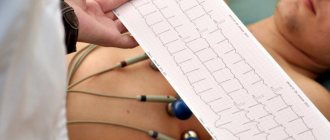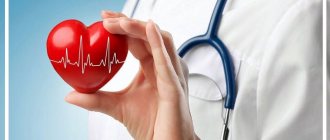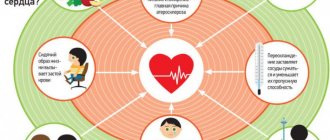Physical education is your main assistant
The benefits of physical therapy are beyond doubt, since, firstly, during active exercise, especially in the fresh air, the cells and tissues of the body are saturated with oxygen, and secondly, blood circulation increases and the heart muscle is strengthened. Aerobic activities that increase the heart rate are preferable - walking, running, skiing, cycling.
It is known that with atherosclerosis, lipids and cholesterol are deposited on the walls of the arteries, thereby leading to a narrowing of the lumen of the vessels and even to their clogging. In the prevention of atherosclerosis, physical education acts as follows. Fatty substances consumed by a person in excess do not settle in the vessels, but are burned by the body during exercise, and their safe level is maintained in the blood, coronary blood flow increases.
Physical activity depends on the age, functional state of the person, and also on whether he or she already has any diseases of the cardiovascular system. Those who have never been involved in physical education and sports should start with walking.
Doctors have found that the minimum dynamic load is as follows: 3 times a week for 30 minutes at a comfortable pace. Those who engage in recreational running should remember that it is not recommended to run more than 30-40 km per week, since in this case the body’s reserves are depleted and performance decreases.
In addition to aerobic exercise, gymnastics has benefits for the body. You can do the following exercises:
- Rotation with hands clenched into fists, as well as feet pointed on toes (20 times in one direction and the other);
- Rhythmic compression-extension of the hands (30 times);
- Rotations of the body left and right with arms spread to the sides (10 times);
- Swing with a straight leg forward, while reaching for your toes (10 swings with each leg);
- Lunges forward with each leg alternately (10-20 times);
- Vertical leg lift to prevent vascular diseases of the legs (1-2 minutes).
This complex can be included in morning exercises, or performed at any convenient time. It is important that the room is well ventilated and that the person wears comfortable clothing that does not restrict movement. But there are a number of the following contraindications to physical education:
- Acute forms of myocarditis, endocarditis, rheumatism;
- Acute heart failure;
- Myocardial infarction;
- Irregular heart rhythm, accompanied by severe pain in the heart area.
To properly structure your training, you need to adhere to the following rules:
- Any load should begin with a warm-up;
- Systematicity involves at least 3 classes per week;
- The pulse should not exceed 120-140 beats per minute;
- If dizziness, pain in the heart or nausea occurs, stop exercising.
Prevention of cardiovascular diseases
Every year, cardiovascular diseases claim the lives of millions of people around the world, and mortality rates from these diseases in Russia are much higher than in developed countries. According to Rosstat, in Russia in 2010, 1 million 140 thousand people died from cardiovascular diseases; in our district the situation is no different from the nationwide one. In the structure of overall mortality, cardiovascular diseases take first place, malignant neoplasms take second place, and external causes of death (primarily injuries and poisoning) take third place.
According to the geographical directory “About Countries”, the average life expectancy of the Russian population is about 66 years, our country ranks 129th in the world, men live on average 59 years, women – 72 years. In first place in terms of life expectancy is the small country of Andorra - 82.7 years, Japan in second - 82 years, Canada in 10th place - 80.4 years, the USA in 30th place - 78.1 years.
The following factors influence the state of human health and actual life expectancy:
- lifestyle – by 50%.
- human genetics – by 20%.
- natural and climatic conditions – by 20%.
- healthcare – by 10%.
If you are thinking about your well-being, we invite you to evaluate
your risk of dying from cardiovascular disease in the next 10 years. The European SCORE* risk assessment scale allows you to determine whether you are at risk of dying from these diseases in the next 10 years. To do this, you first need to measure your blood pressure and take a blood test for cholesterol. Having received the results, select the part of the scale you need depending on your gender, whether you smoke or not, and also taking into account your age (indicated in the middle part of the scale).
Next, find your systolic blood pressure numbers on the vertical left (for example, 160 mmHg), and the level of total blood cholesterol at the bottom horizontally (for example, 6 mmol/l). The intersection of two conditional lines (systolic blood pressure level and cholesterol level) will indicate a figure corresponding to your risk of death from myocardial infarction or stroke over the next 10 years.
For example, a 65-year-old man who smokes has a systolic blood pressure of 160 mmHg. and blood cholesterol level 6 mmol/l, the risk is 25%.
SCORE scale to determine the risk of death from cardiovascular disease in the next 10 years
A convenient interactive calculator that will help you calculate the risk of death from cardiovascular disease in the next 10 years is posted on the website of the “Code of Health and Longevity” www.kzid.ru.
Remember that a SCORE risk score of 5% or more indicates a high risk of dying from a heart attack or stroke in the next 10 years, even if the person currently feels healthy.
If you find yourself in a high-risk group, don’t despair!
Doctors are ready to help you, but your active participation is required. By following your doctor's prescriptions and our simple recommendations, you can maintain your health.
In 2005, the World Health Organization identified the main risk factors predisposing to the development of the disease. We cannot change some risk factors (heredity, gender, age), but there are others that we can influence. This:
- High blood pressure.
- Increased cholesterol levels in the blood (hypercholesterolemia).
- Smoking.
- Alcohol and drug use.
- Obesity.
- Low physical activity (physical inactivity).
- Poor nutrition (insufficient consumption of fruits, vegetables, clean drinking water).
By eliminating these factors (completely or at least partially), you can
not only improve your well-being (and this is also very important!), but also live longer on average by 15 years.
Do you have high blood pressure?
- Monitor your blood pressure and carefully follow your doctor's recommendations.
- Remember: the less salt the better! Do not add salt to your food, do not add more than 6 grams of salt per day to your food (less than a teaspoon), or better yet, give it up altogether! To improve the taste of food, you can add lemon juice, vinegar, herbs and spices.
Do you have high cholesterol in your blood (hypercholesterolemia)?
Cholesterol is one of the main fats that is produced by the liver and also enters our body with food. It is found in all cells of our body and is used as a building material. However, with a high content of cholesterol in the blood, atherosclerosis develops - this is a vascular disease associated with excessive deposition of cholesterol in the vascular wall in the form of plaques that protrude into the lumen of the vessel and narrow it, sometimes until the lumen of the vessel is completely closed. This is similar to a clogged water pipe. Thus, atherosclerosis disrupts the delivery of blood, and therefore oxygen and nutrients, to the organs. This condition is called ischemia. When oxygen delivery is completely stopped, when the lumen of the vessel is “clogged” completely, the organ or part of the organ that the affected vessel supplies with blood dies, through this mechanism myocardial infarction and the most common form of stroke develop, as well as many other diseases (coronary heart disease, brain disease, kidneys, lower extremities).
For most people, total cholesterol levels should be less than 200 mg/dL (5 mmol/L). Do you know your cholesterol level? It can be checked at your clinic when taking a biochemical blood test or at the Health Center (in our district, health centers are located in the cities of Khanty-Mansiysk, Nizhnevartovsk, Nyagan, Nefteyugansk).
The lower your blood cholesterol level, the lower your risk of developing cardiovascular disease!
What to do if your blood cholesterol level is higher than normal?
Eat foods low in fat. Replace butter with vegetable oil, preferably olive oil. Try to stew lean meats and vegetables rather than fry them. Eat fruits and vegetables. Start every meal with a vegetable salad.
When choosing products, use our recommendations:
Healthy - fresh fruits and vegetables, greens, lettuce, spinach, low-fat cottage cheese, low-fat fish, cereals, bran.
Moderation is necessary - cereals, potatoes, legumes (peas, soybeans, beans, lentils), fruits and berries pureed with sugar, milk, fermented milk products (kefir, curdled milk, yogurt), low-fat hard cheeses, lean meat, breast chicken, turkey, eggs, bread, pasta, unsweetened juices.
Should be avoided - everything fried, lard, butter, margarine, mayonnaise, nuts, seeds, fatty meat, meat salads with mayonnaise, fatty sausages and meat products (bacon, brisket, ham, boiled pork, etc.), fatty fish, caviar, fish canned food in oil, sour cream, cream, ice cream, fatty cheeses (more than 30% fat), sugar, candy, chocolate, jam, jam, marmalade, cakes, pastries, pies, sweet juices, cocoa, alcoholic drinks.
Proper nutrition in old age helps us stay healthy and prolongs our lives.
If you follow our recommendations, but within 3 months your cholesterol remains above normal, then consult your doctor. Your doctor may recommend statins, medications that lower cholesterol and other blood fats.
If you smoke, then quit smoking, because it will prolong your life!
Smoking “takes out” the life of a person from 19 to 23 years old. Quitting smoking at any age will bring great benefits to your body. Smoking contributes to the rapid and early development of atherosclerosis. Nicotine damages the walls of blood vessels and promotes increased blood clotting inside the vessels (the formation of blood clots). As a result, the arteries of the heart and brain become clogged, leading to myocardial infarction and stroke.
Do you have a sedentary lifestyle?
Physical inactivity increases the risk of developing and aggravates many diseases: atherosclerosis, obesity, hypertension, diabetes, osteoporosis. Regular physical activity helps to lose weight, and this is a more rational way than dietary restrictions. Physical training is a powerful weapon in the fight against aging; it counteracts the processes that cause your body to become decrepit. Try to move more, take regular walks, and use the elevator less often. The more we move, the less cholesterol is deposited in our blood vessels!
Are you overweight?
By following our recommendations, you can solve this problem, in order to find out if you are obese, take a regular measuring tape and measure your waist circumference, if the value is more than 102 cm for men and more than 88 cm for women, then this indicates a special type obesity – abdominal. Abdominal obesity is another serious sign that indicates a high risk of developing many heart and vascular diseases, as well as metabolic disorders, such as diabetes.
We know that being healthy in old age is not easy. However, it is entirely within your power to make your life more vibrant and interesting - simply by becoming a little healthier by following our simple recommendations!
In preparing the article, materials from the “Code of Health and Longevity” were used. Older age group." A.N.Novozhenova
original article https://cmphmao.ru/node/3
Stress is a blow to blood vessels
The mechanism of action of stress on the cardiovascular system is known: the hormone adrenaline is produced, which causes the heart to beat faster, and the blood vessels spasm and narrow. Because of this, blood pressure increases and the heart muscle wears out.
American scientists have found that the cardiovascular system is directly connected to the brain and hormonal sphere. Therefore, if a person experiences negative emotions - fear, anger, irritability, then the heart will suffer .
To prevent vascular spasms for this reason, a person needs to:
- Spend more time in nature, away from the bustle of the city;
- Learn not to let minor troubles and everyday troubles get close to your heart;
- When you come home, leave all thoughts about business at the door;
- Listen to relaxing classical music;
- Give yourself as many positive emotions as possible.
- If necessary, take natural sedatives, such as motherwort.
Down with bad habits!
Smoking and healthy blood vessels are incompatible. Nicotine spasms blood vessels, so blood pressure rises. In addition, the vascular walls are damaged and plaques are deposited on them, which are the main cause of cardiovascular diseases. The smoker's brain suffers, memory is impaired, and paralysis may occur. Therefore, to prevent the formation of blood clots and destruction of vessel walls, it is necessary to stop smoking.
Another destructive habit is excessive drinking of alcohol. Ethanol acts quickly: under its influence, red blood cells lose their negative charge and begin to stick to each other, worsening the patency of blood vessels, increasing blood clotting and increasing the risk of the formation of extremely dangerous blood clots. Oxygen starvation is experienced not only by organs and tissues, but also by the myocardium; the heart begins to beat faster, depleting its resources. In addition, ethanol interferes with fat metabolism, sharply increasing the level of cholesterol in the blood, and it contributes to the formation of plaques on the walls of blood vessels.
Fans of strong drinks should know that systematic consumption of alcohol, no matter what - beer, wine or champagne, provokes the replacement of the muscle layers of the myocardium with fatty ones. The reception of electrical impulses is disrupted, the ability of the myocardium to contract decreases, and this threatens the appearance of arrhythmias, myocardial ischemia and other severe consequences. There is only one conclusion - reduce alcohol consumption as much as possible, and if it cannot be avoided at a banquet, then simply eat as many fresh green vegetables as possible along with it .
Bad habits include sitting for long evenings in front of the TV or computer. A person who deprives himself of sleep wears out his heart, because he also needs periods of rest. To ensure that the heart does not experience overload, it is recommended to sleep at least 8 hours a day , and this time can be distributed throughout the day.
Preventive measures in old age
The approach of old age causes changes in the body, which also affect the circulatory system. The vessels become rigid and fragile, cholesterol plaques form in them, gradually narrowing the lumen of the coronary arteries. The blood thickens, its flow slows down, as a result of which the nutrition of all tissues of the body deteriorates. The risk of blood clots increases.
Consultations with a cardiologist every six months are a necessary preventative measure for the heart after 40 and 50 years. It is advisable to conduct the following examinations:
- An ECG should be taken; a stress electrocardiogram is recommended for men.
- Take a blood lipid test every year.
- Monitor blood clotting.
- Buy a blood pressure monitor for home and measure your blood pressure regularly.
https://profilaktika-zabolevanij.ru/organy/serdce/
About the benefits of regular examination
Diseases of the heart and blood vessels can occur unnoticed, without any external manifestations. Therefore, you should examine your blood vessels and heart approximately once a year using the basic available methods .
- ECG (electrocardiography). This method is based on recording the heart rhythm using special electrodes. Allows you to identify disturbances in the functioning of the myocardium, intracardiac patency, etc.;
- Ergometry. The essence of the technique is to study the functioning of the cardiovascular system in dynamics;
- Ultrasound Dopplerography (Doppler ultrasound). It is used mainly for the prevention of cerebrovascular diseases. The doctor evaluates blood flow in the large vessels of the neck and head;
- MRI (magnetic resonance imaging). Using MRI, specialists determine the patency of blood vessels, the presence of blood clots, its anatomy and diameter. Its advantages are obvious: efficiency, accuracy and harmlessness to the patient.
- MRA (magnetic resonance angiography). This method is the most modern and effective, especially when diagnosing the condition of cerebral vessels, since it allows one to obtain a three-dimensional image of the vascular network of the area under study. If the blood vessels of the body are examined, a special dye is injected into the artery or vein, thanks to which the images are clear and understandable.









